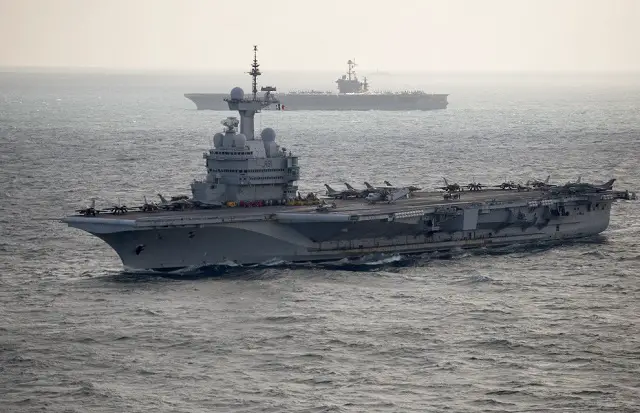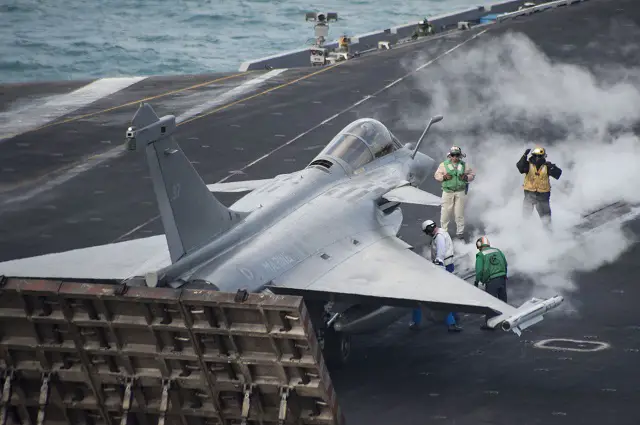Interview with US Navy CNO Admiral Richardson and Chief of French Navy Admiral Prazuck
 USS Harry S Truman and Charles de Gaulle aircraft carriers underway side by side as part of Dual Carrier Operations in the Arabian/Persian Gulf in February 2016. French Navy picture. |
|||
What
do you expect of the next major events between the Marine Nationale and
the U.S. Navy in terms of operational naval cooperation? CNO: Throughout my tenure as CNO, I intend to prioritize key international partnerships, like that partnership we enjoy with the French Navy, through information sharing, greater interoperability initiatives, and increased numbers of combined operations. Beyond the success demonstrated by the recent work with the CDG strike group and recent collaboration on NATO and EU missions in the Mediterranean, both our navies have hosted multilateral dialogues on maritime security in the Gulf of Guinea. By virtue of having these conversations, we have identified opportunities to improve coordination and information sharing to maximize our support to maritime forces in the region. During the recent pirate attack on MT MAXIMUS in the Gulf of Guinea, the French Navy passed information to USNS SPEARHEAD. USNS SPEARHEAD tracked and identified the hijacked vessel and gave the ship's location and coordinates to the relevant local nations to conduct the necessary search and rescue mission. Again, this type of operation is indicative of our close partnership, and the French Navy’s ability to perform at the highest levels. We also are taking advantage of opportunities to exercise air defense capabilities with French anti-air warfare frigates in support of the ballistic missile defense mission. As I mentioned, I expect these types of operations to grow with time. CEMM: First of all, interoperability can’t ever be taken for granted: you need to keep momentum. That’s why FR and US frigates and destroyers are, on a permanent basis, deployed to the same theatres. This is the baseline to allow bigger ships to integrate seamlessly when the need arises. I am absolutely clear that this work will continue when Charles de Gaulle is in refit. Her jets will also continue to deploy in the region, in order to remain familiar with a very complex regional environment and keep current with flat top operations. Secondly, we both routinely operate in the Gulf of Guinea. This area is increasingly strategic for many reasons: natural wealth, political instability, rising piracy…I can see our cooperation flourish in this region, where France can provide a long-established regional expertise. While Charles de Gaulle is refitting, our second biggest flat tops, the three “Mistral”-class LHA, will still be available and regularly deploying to Western Africa and the Indian Ocean. I reckon there is a lot of potential for future combined operations there. Finally, we need to hone our advanced ASW skills. We do it better together. We also need to be more agile in information sharing. There’s a lot of recent history involved there; what with the growing high intensity threats returning to the high seas, we don’t have time for complex and inefficient procedures. |
|||
 ARABIAN GULF
(Jan. 13, 2014) A Rafale aircraft, assigned to the French aircraft carrier
Charles de Gaulle, prepares to launch from the aircraft carrier USS Harry
S. Truman (CVN 75) during carrier qualification integration. Harry S.
Truman, part of the Harry S. Truman Carrier Strike Group, is conducting
operations with units assigned to French Task Force 473 to enhance levels
of cooperation and interoperability, enhance mutual maritime capabilities
and promote long-term regional stability in the U.S. Fleet area of responsibility.
(U.S. Navy photo by Mass Communication Specialist 3rd Class Karl Anderson/Released)
ARABIAN GULF
(Jan. 13, 2014) A Rafale aircraft, assigned to the French aircraft carrier
Charles de Gaulle, prepares to launch from the aircraft carrier USS Harry
S. Truman (CVN 75) during carrier qualification integration. Harry S.
Truman, part of the Harry S. Truman Carrier Strike Group, is conducting
operations with units assigned to French Task Force 473 to enhance levels
of cooperation and interoperability, enhance mutual maritime capabilities
and promote long-term regional stability in the U.S. Fleet area of responsibility.
(U.S. Navy photo by Mass Communication Specialist 3rd Class Karl Anderson/Released)
|
|||
Do
you believe we could see French Navy jets flying combat missions from
a US Navy aircraft carrier in the near future? CNO: We have already conducted air wing training together on numerous occasions and continue to share information and carryout regular aviation personnel exchanges. If operations necessitated it, our two air wings could operate simultaneously from the decks of each other's aircraft carriers. CEMM: Absolutely. French pilots are partly trained in the US; both navies practice catapult assisted take-offs and arrested landings. We have already demonstrated that F-18 could be operated from the CDG. It is technically and tactically absolutely realistic both ways. So far, demonstrations of US - French interoperability have taken place mainly in the Persian-Arabian Gulf region. Could it happen in other parts of the world? CNO: Building on the progress made so far, our two navies will continue work together wherever necessary to improve combined maritime and national security. From the Gulf of Guinea to the Baltic, the South China Sea, the Indian Ocean and elsewhere, we are collaborating and will continue to work together. CEMM: I believe the root cause of this observation is quite simply that our interoperability is most visible in those heated areas of operation. You mentioned the Gulf, but as we speak, Charles de Gaulle is deployed in Eastern Med, operating alongside other US warships, as seamlessly as in the Gulf. Are there other fields in which you cooperate? CNO: I greatly appreciated my opportunity to work with Admiral Rogel. His effort to improve the interoperability of our two navies has been unprecedented, and exceedingly important. I look forward to working now with Admiral Prazuck and I know we will continue to nurture bilateral and multilateral efforts to increase our naval interoperability. CEMM: I returned from the International Strategic Symposium in Newport (RI) last week with the warm feeling that this interpersonal relationship is here to last. Beyond respect, friendship and interoperability at sea, I sense that intensifying this CSG cooperation in the Gulf 3 years ago has opened a new era of strategic partnership between our navies. |
|||



























